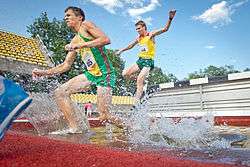Steeplechase (athletics)

The steeplechase is an obstacle race in athletics, which derives its name from the steeplechase in horse racing. The foremost version of the event is the 3000 metres steeplechase. The 2000 metres steeplechase is the next most common distance.
History
.jpg)
The event originated in Ireland. Horses and riders raced from one town's steeple to the next. The steeples were used as markers due to their visibility over long distances. Along the way runners inevitably had to jump streams and low stone walls separating estates. The modern athletics event originates from a two-mile (3.2 km) cross country steeplechase that formed part of the University of Oxford sports (in which many of the modern athletics events were founded) in 1860. It was replaced in 1865 by an event over barriers on a flat field, which became the modern steeplechase. It has been an Olympic event since the inception of the modern Olympics, though with varying lengths. Since the 1968 Summer Olympics, steeplechase in the Olympics has been dominated by Kenyan athletes, including the current gold medal streak since 1984 and a clean sweep of the medals at the 1992 and 2004 Games.
The steeplechase for women is 3,000 metres long, but with lower barriers than for the men. A distance of 2,000 metres, with a shorter water jump, was experimented with before the current race format was established. It made its first major championship appearance at the 2005 World Championships in Helsinki. In 2008, women's 3,000 metres steeplechase appeared for the first time on the Olympic tracks in Beijing (see Athletics at the 2008 Summer Olympics – Women's 3000 metres steeplechase).
Other divisions including masters athletics and youth athletics run 2,000 metres distances. The format for a 2,000 metre steeplechase removes the first two barriers of the first lap.[1]
The steeplechase at the 1932 Olympics was run over approximately 3460 metres due to a lap scoring error.
Format
A 3,000 metres steeplechase is defined in the rulebook as having 28 barriers and 7 water jumps. A 2,000 meters steeplechase has 18 barriers and 5 water jumps. Since the water jump is never on the track oval, a steeplechase "course" is never a perfect 400 metres lap. Instead the water jump is placed inside the turn, shortening the lap, or outside the turn, lengthening the lap. The start line moves from conventional starting areas in order to compensate for the different length of lap. When the water jump is inside, the 3,000 start line is on the backstretch (relative to the steeplechase finish). When the water jump is outside, the 3,000 start line is on the home stretch. The 2,000 start line reverses that pattern and uses 5/7 the amount of compensation.
Notes and references
External links
| Wikimedia Commons has media related to Steeplechase (athletics). |